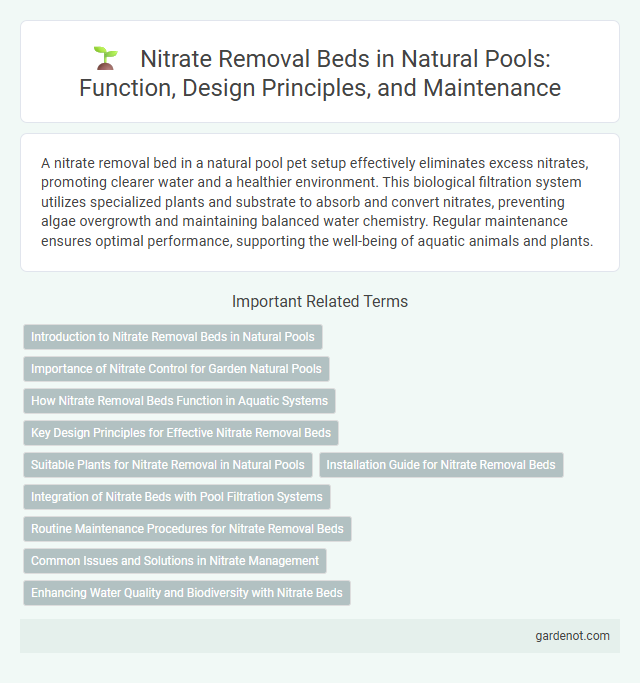A nitrate removal bed in a natural pool pet setup effectively eliminates excess nitrates, promoting clearer water and a healthier environment. This biological filtration system utilizes specialized plants and substrate to absorb and convert nitrates, preventing algae overgrowth and maintaining balanced water chemistry. Regular maintenance ensures optimal performance, supporting the well-being of aquatic animals and plants.
Introduction to Nitrate Removal Beds in Natural Pools
Nitrate removal beds in natural pools utilize specialized substrates and plants to absorb and transform nitrates, preventing algae overgrowth and maintaining water clarity. These beds promote denitrification through microbial activity, converting nitrates into harmless nitrogen gas. This sustainable filtration method enhances the ecological balance and supports healthy aquatic life in natural swimming pools.
Importance of Nitrate Control for Garden Natural Pools
Nitrate control in garden natural pools is crucial to prevent algae overgrowth and maintain water clarity. A nitrate removal bed uses specialized plants and substrates to absorb and break down excess nitrates, promoting a balanced aquatic ecosystem. Effective nitrate reduction supports healthy plant and fish life, ensuring sustainable, chemical-free water quality management.
How Nitrate Removal Beds Function in Aquatic Systems
Nitrate removal beds utilize specialized media, often containing carbon sources and denitrifying bacteria, to facilitate the conversion of nitrates into nitrogen gas through the process of denitrification in aquatic systems. These beds create an anaerobic environment essential for bacteria to reduce nitrate levels, thereby preventing nutrient pollution and eutrophication in natural pools. Optimizing flow rates and substrate composition in nitrate removal beds is critical for maintaining efficient nitrate reduction and supporting overall water quality in natural swimming environments.
Key Design Principles for Effective Nitrate Removal Beds
Effective nitrate removal beds prioritize high surface area media such as woodchips or zeolite to facilitate microbial denitrification processes. Proper hydraulic retention time and flow distribution are crucial to maximize contact between nitrate-rich water and microbial communities. Incorporating anoxic conditions and regular media replacement ensures sustainable nitrate reduction and maintains bed efficiency over time.
Suitable Plants for Nitrate Removal in Natural Pools
Suitable plants for nitrate removal in natural pools include species such as cattails (Typha latifolia), water hyacinth (Eichhornia crassipes), and reed mace (Phragmites australis), known for their high nitrogen uptake capacity. These emergent and floating aquatic plants absorb nitrates efficiently through their roots and leaves, promoting water purification and ecological balance. Incorporating diverse native plants enhances the nitrate removal process, supporting sustainable water quality management in natural pool ecosystems.
Installation Guide for Nitrate Removal Beds
Install the nitrate removal bed by selecting a shaded, well-drained area adjacent to the natural pool to maximize efficiency. Layer the bed with engineered media such as wood chips, sand, and gravel to promote denitrification and maintain optimal water flow. Regularly monitor nitrate levels and replace the media every 3-5 years to ensure continuous nitrate removal and maintain water quality.
Integration of Nitrate Beds with Pool Filtration Systems
Integrating nitrate removal beds with natural pool filtration systems enhances water quality by reducing nitrate levels that promote algae growth and imbalance. These specialized biofilters, often planted with denitrifying vegetation, work synergistically with mechanical filters to maintain ecological stability. Effective integration requires designing flow pathways that direct nitrate-rich water through the bed, optimizing microbial activity and ensuring continuous nutrient cycling.
Routine Maintenance Procedures for Nitrate Removal Beds
Routine maintenance of nitrate removal beds involves regular inspection and replacement of the carbon source material to ensure optimal microbial denitrification. Monitoring water flow rates and nitrate concentration levels helps maintain efficient nitrate removal performance. Periodic cleaning of inlet and outlet structures prevents clogging and supports consistent operational conditions in natural pool systems.
Common Issues and Solutions in Nitrate Management
Nitrate removal beds in natural pools often face issues such as clogging due to organic matter accumulation and inefficient nitrate uptake caused by improper substrate selection. Regular maintenance involving substrate replacement and ensuring optimal plant species with high nitrate absorption can significantly improve performance. Implementing a balanced flow rate prevents stagnation and promotes effective nitrate removal within the bed system.
Enhancing Water Quality and Biodiversity with Nitrate Beds
Nitrate removal beds play a crucial role in natural pools by effectively reducing nitrate levels, thereby preventing algae overgrowth and promoting clearer water. These beds use specialized plants and substrates that facilitate denitrification, enhancing overall water quality and supporting diverse aquatic ecosystems. The improved habitat fosters biodiversity by creating favorable conditions for aquatic life, contributing to a balanced and sustainable natural pool environment.
Nitrate removal bed Infographic

 gardenot.com
gardenot.com